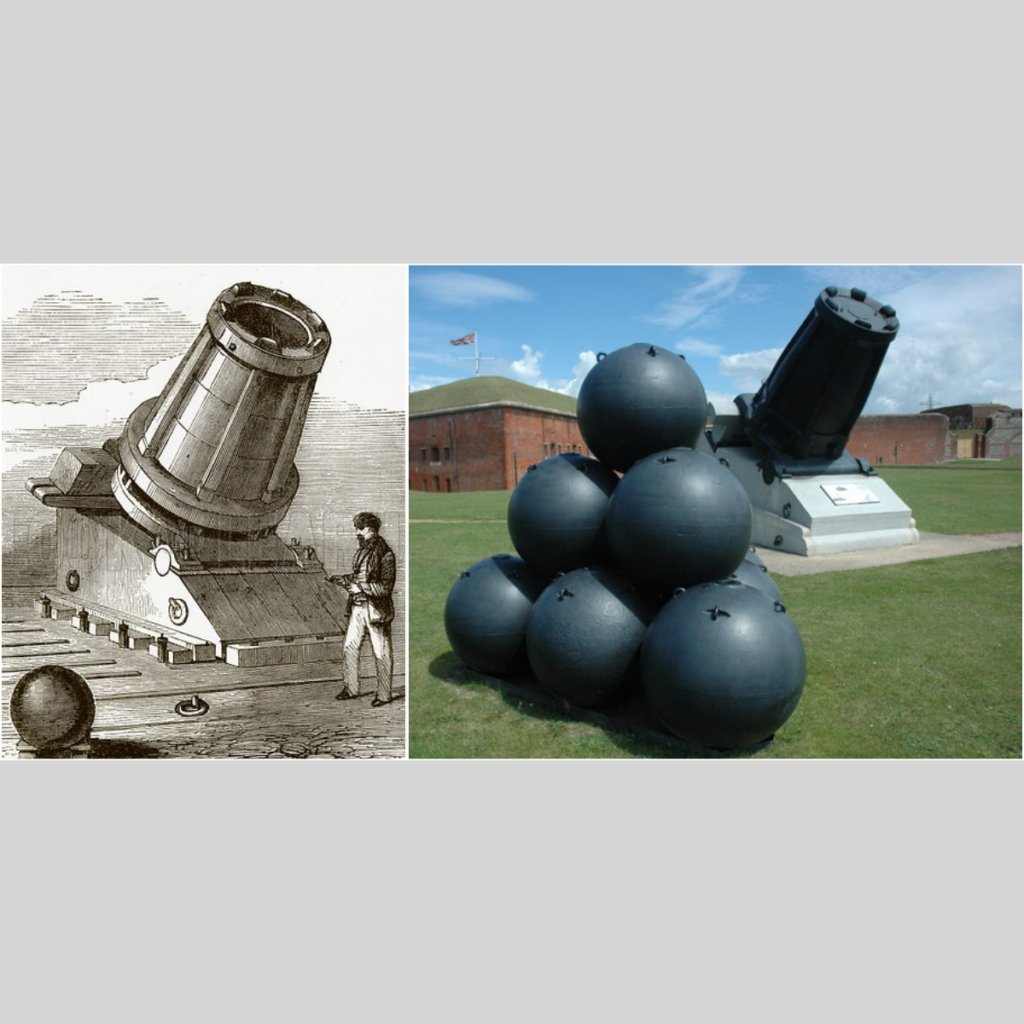
GUN – MORTAR, 36 INCH – 1855-1857
Large Mortar of composite construction. Also known as Mallet’s Mortar. Large mortar of composite construction.
The mortar is composed of a cast-iron base 30 in thick weighing about 7.5 tons. This includes the trunnions and a flange which supports the chase. A hole cut in the base accommodates the wrought-iron chamber or breechpiece which is nearly 70 in long, weighs about 7 tons and projects below the base. The chamber proper, which is bored in this, is 48.5in deep and is coned from a diameter of about 14in at the top, where it is cupped to fit the shell, to 9in at the bottom. The chase, which consists of three rings of wrought iron and a muzzle ring, is clamped to the base by six wrought-iron bolts nearly square in section held at the bottom by gibs and wedge-shaped keys and at the top by heads resting on circular iron washers. Thin rings of wood acted as shock absorbers.
Bed: The mortar was intended to rest on a substantial wooden platform which was fitted with an iron plate or bed to support two heavy beech-wood quoins. These together with an elevating screw gave adjustments in elevation between 40 and 50 degrees. The mortar now rests on a concrete platform to which is bolted the original iron fittings and elevating screw.
| Barrel | Length | 132 in |
|---|---|---|
| Barrel | Length | 3353 mm |
None easily visible
- 36 in
- 914 mm
Robert Mallet
London/Britain/Europe
Designed by the Irish civil engineer and inventor Robert Mallet (1810 – 1881) to throw a shell a yard in diameter, weighing about a ton and a quarter and holding a 480lb bursting charge, powerful enough to penetrate the great earth and stone fortresses of the Crimea. Its construction enabled it to be dismantled for transport into sections none of which weighed more than 12 tons. Mallet’s first design was finished in October 1854. In February 1855 it was submitted to the Board of Ordnance and on the insistence of Lord Palmerston two trial mortars were ordered from the firm of Mare & Co., Blackwall, at a cost of £4900 each. These were not completed until March 1857 owing to difficulties in manufacture and the bankruptcy of the contractors. The work was finished by Horsfall & Co., of Liverpool and Fawcett, Preston & Co. Fifty shells were delivered by Messrs. Hood at a cost of £16 per ton and two cranes for loading costing £150 each were supplied by Messrs. Fox, Henderson & Co. Trials commenced at Woolwich in October 1857 and continued until 28 July 1858, when the nineteenth and last round was fired. This attained the greatest range, 2759 yards, with a charge of 80lb and an angle of 45 degrees, but it broke one of the longitudinal bolts. As this followed a number of small defects and fractures it was decided to abandon the trials. The mortar XIX.286 was assembled at the Arsenal and mounted in front of ‘T’ Pier, Woolwich Arsenal. The trial mortar XIX.305 was repaired and although missing some of its bed fittings, is now mounted at the entrance to Greenhill School, Woolwich on loan to the Royal Artillery Historical Trust. Mallet also proposed that his mortars should be mounted as floating batteries (see Major-General Lefroy, ”The Story of the 36in Mortars of 1855-1858′. Prov. R.A. Inst. VII, 203-39.